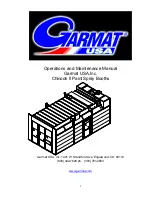
11
2. Read and understand the operator’s manual.
3. Read and familiarize yourself with the safety and warning decals on the ditcher.
4. Check all bolts to verify proper torque.
5. Level the chain case. See the LEVELING THE DITCHER SECTION of this manual
WARNING
Never operate the ditcher above its RPM rating; Excessive PTO speed can cause personal injury
or damage to your tractor and ditcher!
6. Check the ditcher for parts that are broken or have excessive wear. If any are found
replace them.
7. Check to make sure the tractor 3-point hitch is securely attached to the ditcher.
8. Verify the ditcher has been properly lubricated.
9. Check the chain case oil level. This is done by removing the check plug on the side of the
chain case. The oil level should be level with the bottom of the plug hole.
10. Adjust the skid shoe to the initial depth setting as detailed in the Flat and Concaved Skid
Shoe section of this manual.
11. Verify the PTO shaft is firmly connected to the tractor.
12. Slowly raise and lower the ditcher to check the engagement of the PTO shaft. There
should be at least 6” of engagement between the two halves of the PTO shaft.
OPERATING THE DITCHER
WARNING
Before making any adjustments, lubricating or repairing. First, disengage the tractor’s PTO and
wait for the cutter head and cutting blades to come to a complete stop. Then slowly lower the
ditcher until skid shoe is touching the ground. Before dismounting from the tractor shut off the
engine set the parking brake and remove the key.
CAUTION
Make certain there are no underground utilities or pipelines in the area where the ditcher will be
operated. If you are not sure contact your local utilities so they can mark the area. If
underground utilities or pipeline are buried in the area of operation it is important to ask how close
to the locator markers the ditcher can be operated.












































